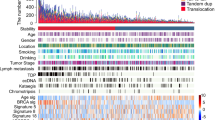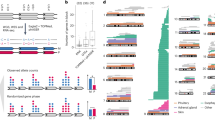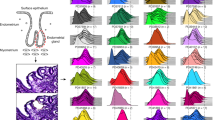Abstract
Exposure to ionizing radiation induces different forms of genomic instability in cultured cells and experimental animals. A higher rate of germline mutations at human hypervariable minisatellite loci was reported in children born from parents exposed to radiation after Chernobyl, implicating genome destabilization as a possible mechanism responsible for late radiation effects in humans. To test if radiation-induced carcinogenesis in the thyroid gland may be associated with somatic minisatellite instability or microsatellite instability, we utilized a PCR-based approach to study normal and tumor DNA from 17 pediatric post-Chernobyl papillary thyroid carcinomas for mutations at three different minisatellite loci (D1S80, D17S30, ApoB), and 27 microsatellite loci of di-, tri-, or tetranucleotide repeats. Minisatellite instability was found in three (18%) tumors, with one of them exhibiting mutations in all three minisatellite loci, whereas two others showed mutations in one of two informative markers. By contrast, none of 20 sporadic thyroid cancers from patients with no history of radiation exposure was positive for minisatellite instability. Microsatellite analysis of post-Chernobyl tumors revealed a mutation in one (6%) tumor only at the locus of D10S1412, whereas all other 26 microsatellite markers showed identical patterns in each normal/tumor pair. Our results suggest that somatic cell microsatellite instability does not contribute to radiation-induced thyroid carcinogenesis. However, somatic minisatellite mutation events are present in a subset of radiation-induced, but not sporadic, thyroid cancers, suggesting that this type of genomic instability may play a role in radiation-induced tumorigenesis in the thyroid gland.
This is a preview of subscription content, access via your institution
Access options
Subscribe to this journal
Receive 50 print issues and online access
$259.00 per year
only $5.18 per issue
Buy this article
- Purchase on Springer Link
- Instant access to full article PDF
Prices may be subject to local taxes which are calculated during checkout
Similar content being viewed by others
Author information
Authors and Affiliations
Rights and permissions
About this article
Cite this article
Nikiforov, Y., Nikiforova, M. & Fagin, J. Prevalence of minisatellite and microsatellite instability in radiation-induced post-Chernobyl pediatric thyroid carcinomas. Oncogene 17, 1983–1988 (1998). https://doi.org/10.1038/sj.onc.1202120
Received:
Revised:
Accepted:
Published:
Issue Date:
DOI: https://doi.org/10.1038/sj.onc.1202120
Keywords
This article is cited by
-
Genetic alterations landscape in paediatric thyroid tumours and/or differentiated thyroid cancer: Systematic review
Reviews in Endocrine and Metabolic Disorders (2024)
-
Microsatellite instability analysis of bilateral breast tumors suggests treatment-related origin of some contralateral malignancies
Journal of Cancer Research and Clinical Oncology (2006)
-
Rearrangements of minisatellites in the human telomerase reverse transcriptase gene are not correlated with its expression in colon carcinomas
Oncogene (2001)



